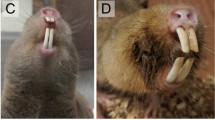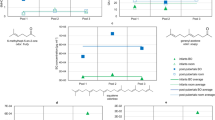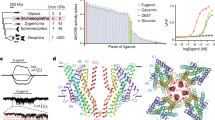Abstract
We report the identification of a physiological receptor-volatile pair in the mouse olfactory system. By activity-guided fractionation of exocrine gland extracts and subsequent chemical analysis, (Z)-5-tetradecen-1-ol was identified as a natural ligand for a mouse odorant receptor. (Z)-5-tetradecen-1-ol is excreted into male mouse urine under androgen control and enhances urine attractiveness to female mice. This report is to our knowledge the first to describe natural product–based deorphanization of an odorant receptor.
This is a preview of subscription content, access via your institution
Access options
Subscribe to this journal
Receive 12 print issues and online access
$259.00 per year
only $21.58 per issue
Buy this article
- Purchase on Springer Link
- Instant access to full article PDF
Prices may be subject to local taxes which are calculated during checkout



Similar content being viewed by others
References
Nei, M., Niimura, Y. & Nozawa, M. Nat. Rev. Genet. 9, 951–963 (2008).
Touhara, K. & Vosshall, L.B. Annu. Rev. Physiol. 71, 307–332 (2009).
Saito, H., Chi, Q., Zhuang, H., Matsunami, H. & Mainland, J.D. Sci. Signal. 2, ra9 (2009).
Civelli, O. FEBS Lett. 430, 55–58 (1998).
Touhara, K. Neurochem. Int. 51, 132–139 (2007).
Uezono, Y. et al. Receptors Channels 1, 233–241 (1993).
Katada, S., Nakagawa, T., Kataoka, H. & Touhara, K. Biochem. Biophys. Res. Commun. 305, 964–969 (2003).
Abaffy, T., Matsunami, H. & Luetje, C.W. J. Neurochem. 97, 1506–1518 (2006).
Saito, H., Kubota, M., Roberts, R.W., Chi, Q. & Matsunami, H. Cell 119, 679–691 (2004).
Zhuang, H. & Matsunami, H. J. Biol. Chem. 282, 15284–15293 (2007).
Von Dannecker, L.E., Mercadante, A.F. & Malnic, B. Proc. Natl. Acad. Sci. USA 103, 9310–9314 (2006).
Yoshikawa, K. & Touhara, K. Chem. Senses 34, 15–23 (2009).
Oka, Y. et al. Neuron 52, 857–869 (2006).
Bozza, T., Feinstein, P., Zheng, C. & Mombaerts, P. J. Neurosci. 22, 3033–3043 (2002).
Touhara, K. et al. Proc. Natl. Acad. Sci. USA 96, 4040–4045 (1999).
Katada, S., Hirokawa, T., Oka, Y., Suwa, M. & Touhara, K. J. Neurosci. 25, 1806–1815 (2005).
Tan, J., Savigner, A., Ma, M. & Luo, M. Neuron 65, 912–926 (2010).
Buser, H.R., Arn, H., Guerin, P. & Rauscher, S. Anal. Chem. 55, 818–822 (1983).
Bartelt, J.R., Jones, L.R. & Krick, P.T. J. Chem. Ecol. 9, 1343–1352 (1983).
Evans, C.M. & Brain, F.P. Physiol. Behav. 21, 19–23 (1978).
Mugford, R.A. & Nowell, N.W. Horm. Behav. 3, 39–46 (1972).
Jemiolo, B., Alberts, J., Sochinski-Wiggins, S., Harvey, S. & Novotny, M. Anim. Behav. 33, 1114–1118 (1985).
Lin, D.Y., Zhang, S.Z., Block, E. & Katz, L.C. Nature 434, 470–477 (2005).
Horiike, M., Tanouchi, M. & Hirano, C. Agric. Biol. Chem. 44, 257–261 (1980).
Cork, A., Murlis, J. & Megenasa, T. J. Chem. Ecol. 15, 1349–1364 (1989).
Krautwurst, D., Yau, K.W. & Reed, R.R. Cell 95, 917–926 (1998).
Fukuda, N. et al. Eur. J. Neurosci. 27, 2665–2675 (2008).
Acknowledgements
This work was supported in part by a Grant-in-Aid for Scientific Research (S) from the Ministry of Education, Culture, Sports, Science and Technology Japan (grant 24227003), a Grant-in-Aid for Scientific Research on Priority Areas from the Japan Society for the Promotion of Science (JSPS) (grant 18077001) and a research grant from the Astellas Foundation for Research on Metabolic Disorders to K.T. K.Y. was supported by a Grant-in-Aid for JSPS fellows. We thank T. Ando for Z8-14:OH (Tokyo University of Agriculture and Technology), and T. Kikusui and T. Hattori for advice on behavioral experiments.
Author information
Authors and Affiliations
Contributions
K.Y. performed experiments; H.N. identified δ-undecalactone as a synthetic ligand for Olfr288; N.M. generated the reagents; K.Y and K.T. designed the research, analyzed data and wrote the manuscript; H.W. and K.T. supervised the work.
Corresponding author
Ethics declarations
Competing interests
The authors declare no competing financial interests.
Supplementary information
Supplementary Text and Figures
Supplementary Results (PDF 3103 kb)
Rights and permissions
About this article
Cite this article
Yoshikawa, K., Nakagawa, H., Mori, N. et al. An unsaturated aliphatic alcohol as a natural ligand for a mouse odorant receptor. Nat Chem Biol 9, 160–162 (2013). https://doi.org/10.1038/nchembio.1164
Received:
Accepted:
Published:
Issue Date:
DOI: https://doi.org/10.1038/nchembio.1164
This article is cited by
-
Hemoglobin in the blood acts as a chemosensory signal via the mouse vomeronasal system
Nature Communications (2022)
-
Contribution of individual olfactory receptors to odor-induced attractive or aversive behavior in mice
Nature Communications (2019)
-
Identification and Field Testing of Volatile Components in the Sex Attractant Pheromone Blend of Female House Mice
Journal of Chemical Ecology (2019)
-
Associative learning is necessary for airborne pheromones to activate sexual arousal-linked brain areas of female rats
Behavioral Ecology and Sociobiology (2019)
-
Sexual rejection via a vomeronasal receptor-triggered limbic circuit
Nature Communications (2018)



